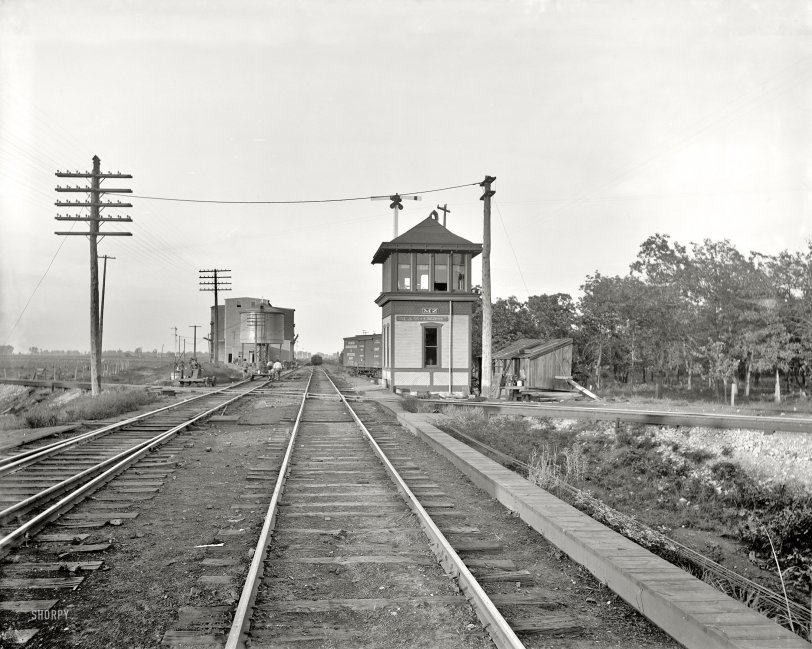


Framed or unframed, desk size to sofa size, printed by us in Arizona and Alabama since 2007. Explore now.
Shorpy is funded by you. Patreon contributors get an ad-free experience.
Learn more.

- Tough Guys
- Lost in Toyland
- And without gloves
- If I were a blindfolded time traveler
- Smoke Consumer Also Cooks
- Oh that stove!
- Possibly still there?
- What?!?
- $100 Reward
- Freeze Frame
- Texas Flyer wanted
- Just a Year Too Soon
- WWII -- Replacing men with women at the railroad crossing.
- Yes, Icing
- You kids drive me nuts!
- NOT An Easy Job
- I wonder
- Just add window boxes
- Icing Platform?
- Indiana Harbor Belt abides
- Freezing haze
- Corrections (for those who care)
- C&NW at Nelson
- Fallen Flags
- A dangerous job made worse
- Water Stop
- Passenger trains have right of way over freights?
- Coal
- Never ceases to amaze me.
- Still chuggin' (in model form)
Print Emporium
Mazonia: 1900

Circa 1900. "Chicago & Alton Railroad. Signal station and crossroads at Mazonia, Illinois." 8x10 inch glass negative, Detroit Publishing Co. View full size.
Gandy Dancers
fixing the track, and those cables on the left are to operate switches down the track, in the foreground you can see where the cables go under the track to the opposite track.
Flag Stop?
There's no town here, and probably never was one; that mass of trees conceals a great expanse of marsh. Lacking my 1948 Handy Railroad Atlas I couldn't tell you whose line cut across the C&A here, but in any case the track is gone. If you look at the Google aerial view you can just barely find a trace of it to the northwest. There's still a junction here, though: the line that bends off to the left (see the semaphore to the left of the handcar) is still there.
The wires down on the ground most likely controlled the signals; it looks a bit haphazard but I don't think there's enough room under the boards to put rods for everything.
Cable conduit
I've only been in one railroad switching tower in my life, and that was nearly 50 years ago, but I'm pretty sure the switches were all mechanically operated. So those "wires" along the track are probably the cables running from the operating levers (you can just see the tops of them in the tower's windows) to the switches.
No Plates
What wonderful detail of track construction at the turn of the century. This photo still shows that they were not using tie plates (metal plates placed between the crosstie and rail to make the structure more stable and keep the rail from cutting into the ties). Amazingly, other than the rail becoming heavier and larger through the years, most of the other features of construction remain to this day. Main lines have mostly gone to continuous welded rail these days, eliminating those "clickity-clack" joints, but industrial and older yard tracks still have the angle bars (splice bars) and bolts joining each length of rail. There also has been little improvement in the design of those crossing frogs, where the steel wheels still must bang across about an inch gap in the rail used to accommodate the flanges of the rails for the crossing route.
Re: Iron Mountain Baby
What a great story! Thanks for the link!
The photos and meticulous work restoring and adjusting them make this site a wonderful resource, but the comments often enhance the stories immensely. Just one more thing I love about Shorpy!
MZ
The "MZ" sign designates the telegraph code for this interlocking tower. Each operating point on the railroad had a unique code assigned to it.
Route 66
About 26 years later Route 66 would follow alongside the northern Illinois part of the Chicago & Alton RR from Chicago down to Springfield.
Do RR folks know why the wires are running so close to the ground on the right? I assume the covered raceway covers the mechanical links to switches behind the photographer.
Iron Mountain Baby
The boxcar behind the tower is from the St Louis, Iron Mountain and Southern Railway, which is famous in railway folklore for the Iron Mountain Baby.
























On Shorpy:
Today’s Top 5